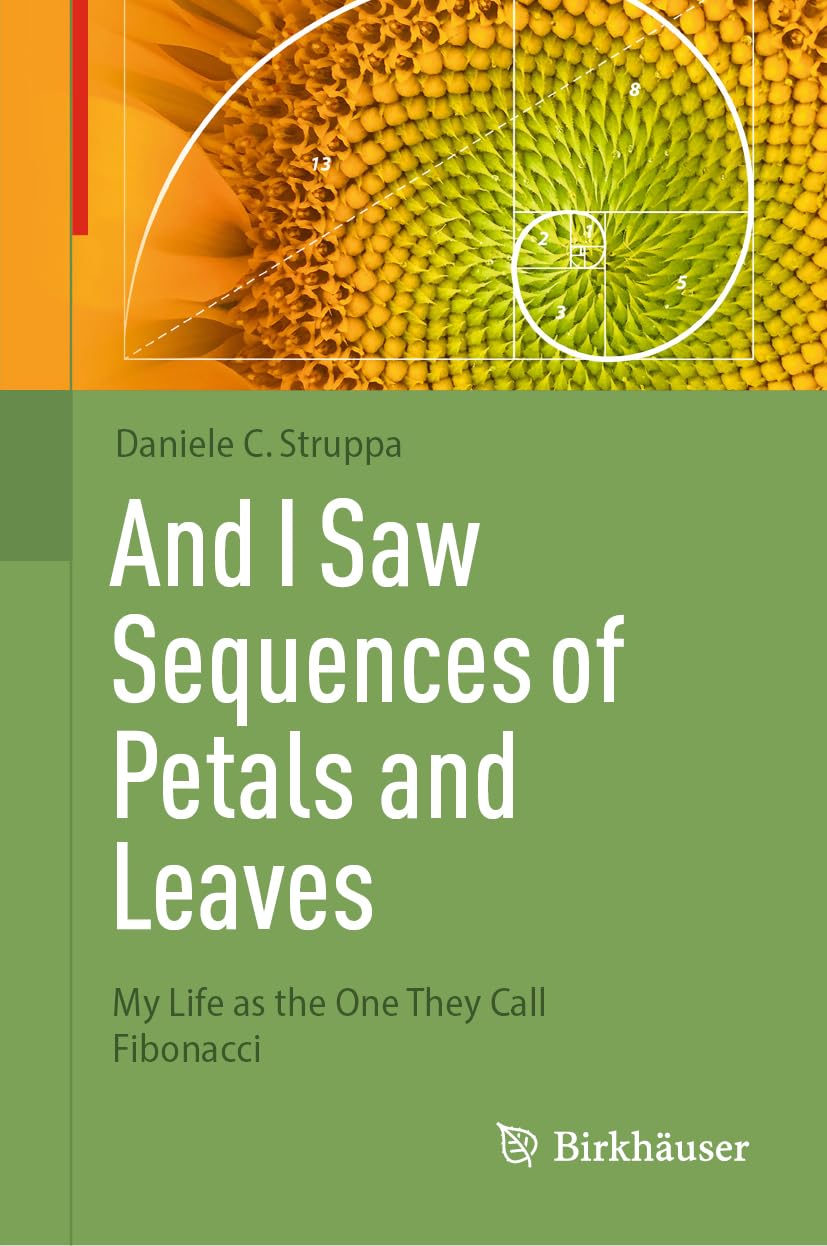
- Author: Daniele C. Struppa
- Publisher: Birkhäuser Cham
- Publication Date: 04/03/2024
- Number of Pages: 134
- Format: Paperback
- Price: $39.99
- ISBN: 978-3-031-52694-7
- Category: none
[Reviewed by Joel Haack, on 11/13/2024]
Daniele Struppa’s And I Saw Sequences of Petals and Leaves: My Life as the One They Call Fibonacci is an attractive work of creative non-fiction. Extensive research is required to do this successfully. The author cites nearly 100 useful references in his bibliography and includes 169 endnotes, many of which amplify the discussions in the book with additional details.
Struppa has Leonardo Fibonnaci tell his story in a first-person narrative, including the meager facts known of Leonardo’s life, then fleshing it out with imagined thoughts, conversations, activities, and secondary characters that fill in the gaps in the historical record. Our author is careful to make clear what is historically known, what are reasonable reconstructions of the details of Leonardo’s life, and what are more fanciful ideas of what might have been. He also provides mathematical details in appendices to two chapters so that readers who are not as interested in the mathematics can proceed comfortably without reading them. Struppa writes “the goal of the book is to portray a transformational moment in history, and a central figure in that transformation.” (6) He has succeeded in doing so.
Struppa’s first chapter explains how he became interested in Leonardo and discusses the approach he is taking in this book. In Chapter 2, Leonardo begins the first-person account of his life, starting with his boyhood in Pisa, with details based on his family background and what life was like at that time and place. An appendix on spirals in nature is quite accessible to a general audience. In the next chapter, we travel with Leonardo to Bugia where Leonardo learns the Indo-Arabic numerals.
Chapter 4 introduces several fictional characters who help Leonardo learn about daily life in northern Africa, the Arabic language, and mathematics. A discussion of the difficulty in performing arithmetic operations with Roman numerals helps show why the Indo-Arabic numeration system will be of great advantage to merchants in Pisa, a particular interest of Leonardo’s as his father was an official in the Pisan customs house. It also suggests that Leonardo first explores the Fibonacci sequence via a consideration of the number of ancestors of drone bees in the context of the honey industry in Bugia.
In Chapter 5, Leonardo takes us on a guided tour of his most important work, the Liber Abaci, which first appeared in 1202. The chapter includes an amusing tale of Leonardo’s difficulty in teaching uninterested students, where the authorities choose to ‘punish’ him by removing his teaching assignment while insisting he continue his mathematical research at the same salary. Here an appendix discusses the Fibonnaci Sequence.
Chapter 6 presents the interaction of Leonardo with the court of the Holy Roman Emperor Federico II. We find brief descriptions of later extant works of Leonardo—De Practica Geometriae, Flos, and the Liber Quadratorum. In Chapter 7 Struppa speculates on the older Leonardo, suggesting he became interested in chess and pursuing, of course, relationships between mathematics and chess.
This book is a pleasant read. It would be accessible to high school and undergraduate students interested in an introduction to Leonardo and his times.
Joel Haack is Emeritus Professor of Mathematics at the University of Northern Iowa.
